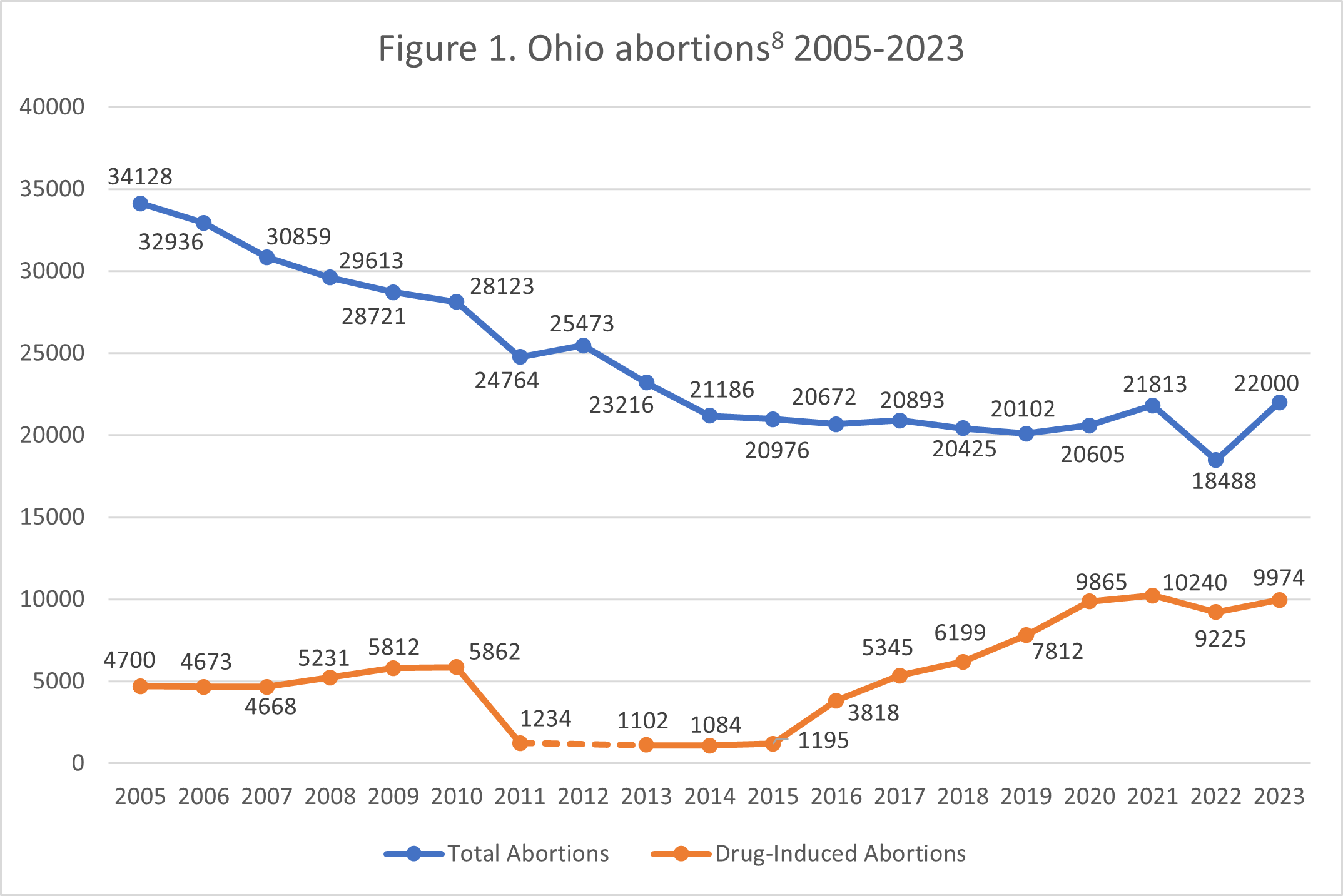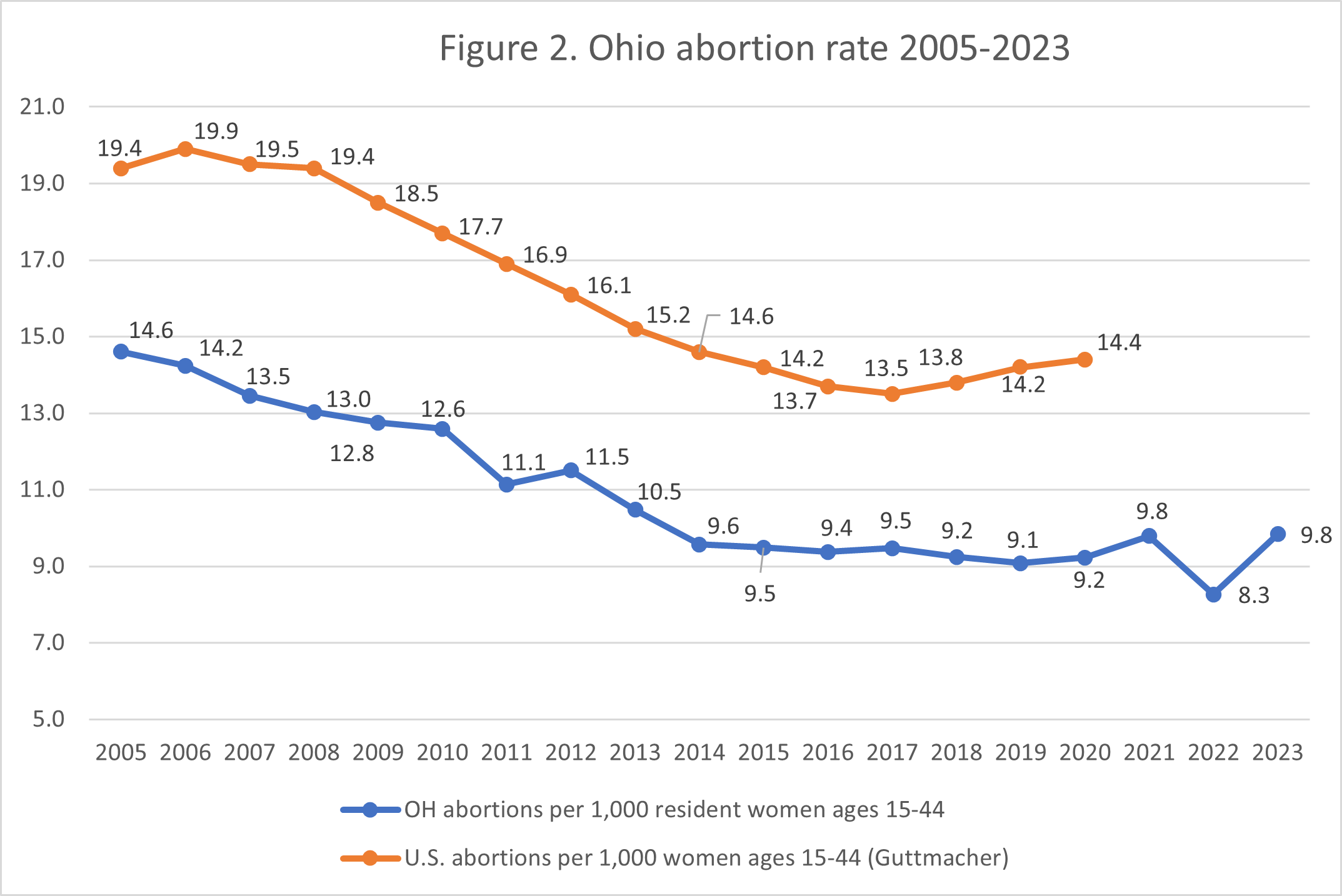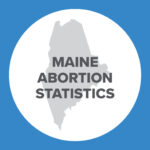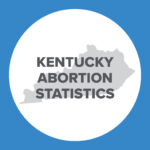Abortion Reporting: Ohio (2023)
Ohio’s 2023 abortion report was published in September 2024 by the Ohio Department of Health. Abortions increased in the state from 2022. Charlotte Lozier Institute (CLI) is summarizing the information in the abortion report published by the state. The data published by the state does not include the total number of abortions obtained by Ohio residents out of state or the number of self-managed abortions on women outside of the healthcare system. It is also unlikely that the report contains the number of mail-order abortion drugs obtained by Ohio residents prescribed by licensed abortion providers in other states. In a separate section, CLI will describe data provided by the Guttmacher Institute’s Monthly Abortion Provision Study that details the number of women who traveled to Ohio to obtain abortions and their states of residence as well as the number of abortions obtained by Ohio women in other states. Guttmacher’s abortion estimates include the number of abortions obtained at brick-and-mortar facilities and those provided via telehealth and virtual providers in the United States
Statistics and Changes in Ohio Abortions, 2022-2023

This report does not include information on Planned Parenthood’s Ohio abortion market share.
Abortion Totals and Trends
In 2023, there were 22,000 abortions reported in Ohio, an increase of 19% from 2022. Drug-induced abortions also increased from the previous year, from 9,225 in 2022 to 9,974 in 2023. Drug-induced abortions made up 45% of the state’s abortion total in 2023, a smaller percentage than drug-induced abortions constituted in 2022 (50%) (Fig. 1). CLI estimates that Ohio’s 2023 abortion rate was 9.8 abortions per 1,000 women of childbearing age, an increase of 19% (Fig. 2).1 As of November 2024, 21 states have released 2023 abortion reports, nine of which showed that abortions had increased from the year before.
State Report Summary
The vast majority of Ohio abortions (87%) were reported to have been performed on resident women, while 13% were obtained by nonresidents. The number of nonresident women who obtained abortions in Ohio doubled in 2023 from the number of nonresidents in 2022. One possible explanation for the increase in nonresidents obtaining abortions in Ohio is that abortion in Ohio continues to be legal up until 22 weeks, but it borders Kentucky and West Virginia which have both prohibited abortion from conception since the Dobbs decision in summer 2022 except in limited cases. Ohio also borders Indiana whose life at conception law went back into effect in August 2023. However, Ohio’s abortion report does not detail the specific states that nonresidents travel from to obtain abortions in Ohio. It is important to note that the increase in the total number of abortions performed in Ohio from 2022 to 2023 was driven by the increase in the number of both resident and nonresident women obtaining abortions in Ohio.
Nine percent of Ohio abortions were performed on girls ages 19 and younger (including 3% on girls under the age of 18). Fifty-seven percent were performed on women in their twenties, with 29% on women ages 20 to 24 and 28% on women ages 25 to 29. Thirty-one percent were performed on women in their thirties, and 3% on women ages 40 and older. One woman’s age was outside the fertility range.
Eleven percent of Ohio abortions were performed on women who had not graduated from high school, and 41% were performed on women with a high school diploma or its equivalent as their highest level of education. Nineteen percent were performed on women with some college but no degree, and 20% were obtained by women who had received an associate degree or higher. Level of education was not reported for 8% of the abortions that occurred in Ohio.
Eighty-two percent of the abortions were obtained by unmarried women, and 12% were performed on women who were married or separated from their spouses. Marital status was not reported for 6% of the abortions. One quarter of the abortions were performed on women with no previous pregnancies, 18% were performed on women with one prior pregnancy, and 54% were performed on women with two or more previous pregnancies. The number of previous pregnancies was unreported for 3% of the abortions.
Fifty-seven percent of the abortions were performed on women who reported no previous abortions, compared to 22% with one prior abortion and 17% with two or more prior abortions. Thirty-five percent of the abortions were performed on women with no living children, 25% on women with one child, and 37% on women with more than one child. The number of previous abortions and number of living children were not reported for 4% and 3%, respectively, of the women who obtained abortions.
In 2023, 44% of Ohio abortions were performed on black women. Forty-one percent were obtained by white women, and 3% by Asian or Pacific Islander women. Sixty-five abortions (0.3%) were performed on Native American women, and 4% were performed on women of multiple races. Race was not reported for 8% of abortions. CLI estimates that the black abortion rate was 28.7 abortions per 1,000 women of childbearing age, over five times the white abortion rate of 5.1. Seventy-four percent of Ohio abortions were obtained by non-Hispanic women, while 7% were obtained by Hispanic women and 18% by women of unknown ethnicity.
Ohio allows multiple methods to be reported for each abortion. In 2023, there were 22,056 procedures used, compared to 22,000 abortions reported in the state. Forty-five percent of the abortions were drug-induced. Forty-six percent were performed using suction curettage and 9% were performed using dilation and evacuation. There were seven abortions that used dilation and extraction (the same procedure used in partial birth abortions), four hysterotomy abortions, and five hysterectomy abortions. Ohio’s partial birth abortion law as well as federal law prohibits the use of dilation and extraction unless the unborn baby is killed prior to being partially born. There were 18 abortions performed using other, unspecified surgical procedures and one abortion performed via an unspecified method.
Sixty-one percent of Ohio abortions occurred at eight weeks of gestation or earlier. Twenty-six percent were performed between nine and 12 weeks, and 11% were performed between 13 and 18 weeks of gestation. Two percent were performed between 19 and 20 weeks of gestation, and 145 abortions were performed between 21 and 24 weeks. One abortion was performed between 25 and 36 weeks. Ohio’s 22 week law contains exceptions to preserve the life and physical health of the mother, but the report did not note if the abortion performed between 25 and 36 weeks implicated one of those exceptions. From 2022 when the state’s heartbeat law was in effect for a portion of the year to 2023 when the state’s 22 week law was in effect for the entirety of the year, the percentage of abortions performed between 19 and 20 weeks increased by 40% and 36% for abortions performed at 21 weeks gestation or later.
More than one method of determining gestational age could be reported for each abortion. Ultrasound was used to estimate gestational age for most abortions (96%), and the last menstrual period was used for 24%. A clinical exam was used in 19% of the cases, while some other means was used to calculate gestational age in five cases.
Beginning at 19 weeks of gestation, Ohio requires that doctors test to see if the unborn baby is viable. Of the 476 abortions performed at 19 weeks or later in 2023, one was performed on a viable baby. Ultrasound was used to test viability in 471 cases and the baby’s weight was used in seven. Six other abortions used other, unspecified methods.
In 2023, there were 10 abortions performed after 20 weeks post-fertilization (22 weeks of gestation). The report does not indicate the justification for these abortions or if they were performed because the woman’s life or a major bodily function was in danger. Thirty women were reported to have a medical condition other than “good” at the time of their abortion, but the report does not state whether any of those women obtained abortions after 20 weeks post-fertilization.
In 2023, 36 abortion reporting forms indicated that the abortion had resulted in complications.2 Multiple complications could be reported for each abortion, and 41 total complications were reported. There were nine cases of hemorrhage and seven incomplete abortions. There were six cases of a hematometra, four failed abortions, and three cases of a cervical laceration. There was one infection and one case of a perforated uterus. There were ten cases of other, unspecified complications.
Ohio also received 121 post-abortion care report forms reporting 142 complications. There were 48 incomplete abortions (when pieces of the unborn baby or placenta were retained in the uterus) and 41 failed abortions (typically referring to ongoing pregnancy). Hematometra occurred 20 times, infection 11 times, and hemorrhage nine times. There was one case each of a perforated uterus and a cervical laceration. There were 11 other unspecified complications.
Ohio has an adverse event reporting system for drug-induced abortions; however, it is separate from the state’s annual abortion report released by the health department. When a complication arises from a drug-induced abortion, the doctor who administered the abortion drugs must report the complication to the Ohio State Medical Board and the health department.
Fifty-six percent of the abortions were performed on women who said they were not using contraception at the time they became pregnant, while 15% were performed on women who were using contraception. Contraceptive use was not reported for 29%. Contraception was recommended after all abortions.
Ohio reports the type of counseling provided in advance of an abortion, and women can report having obtained multiple forms of counseling before their abortion. Sixty-two percent of the abortions were performed on women who had received medical counseling, and 19% on women who had received counseling from social services. Psychological counseling was provided before 18 abortions, and pastoral counseling was provided before 14 abortions. Thirteen women received some other form of counseling, while 37% did not receive counseling.
Ohio administrative code requires that for all abortions performed at 14 weeks of gestation or beyond, written discharge instructions be given to the woman. The law stipulates that the instructions contain the following information:
- Symptoms of complications to pay attention to and the appropriate and recommended response if any symptoms arise;
- Activities to be avoided following the abortion;
- Notice of the existence of a 24-hour emergency service;
- Comprehensive birth control information;
- The date of a follow-up visit if the condition of the woman necessitates one in the doctor’s judgement and the importance of the follow-up visit;
- How to appropriately take medications if any are prescribed to the woman;
- How to care for her body after the abortion
In 2023, for 2,282 abortions, the woman was given the appropriate information.
The majority of Ohio’s abortions (85%) were performed in ambulatory surgical facilities. Fourteen percent occurred in non-surgical clinics, and 134 abortions were performed in hospitals.
Abortion Data and Ohio’s Heartbeat Law
As previously mentioned, Ohio’s heartbeat law went into effect immediately after the Dobbs decision was handed down on June 24, 2022. However, it was indefinitely blocked on September 14, 2022, and permanently blocked on October 24, 2024. While the law is no longer in effect, certain statutory and administrative reporting requirements related to this law still remain in effect and were included in the state’s 2023 abortion report. Of the 22,000 abortions performed in Ohio in 2023, there were 10,825 cases in which the abortion was performed after a fetal heartbeat was detected. A fetal heartbeat was not detected for 1,509 abortions and not reported for 9,666 abortions. One hundred and eighteen abortions were performed because of a medical necessity or emergency, while 9,581 were not. It was not reported for 12,301 abortions whether the abortion was medically necessary or not. Of the 118 abortions performed because of medical necessity or emergency, 50 medical conditions were specified and 28 were labelled as “other.” More than one medical condition could be reported for a single patient, and the Ohio report does not specify how many women had a particular medical condition reported prior to the abortion. There were 21 cases of PPROM (premature rupture of the membrane), nine cases of an “inevitable abortion,” seven cases of cardiac disease, six cases of hemorrhage, and four infections. There were two cases of pre-eclampsia and one case of diabetes. There were 28 other, unspecified medical conditions that constituted a medical necessity.3
Abortions by County of Occurrence and Residence
Abortions performed in Ohio were performed in 11 of its 88 counties. The number of abortions occurring by county is as follows (in descending order):4
- Cuyahoga County – 6,111 abortions (3 abortion providers exist in the county)
- Montgomery County – 4,283 abortions (1 abortion provider exists in the county)
- Hamilton County – 3,611 abortions (1 abortion provider exists in the county)
- Summit County – 3,603 abortions (1 abortion provider exists in the county)
- Franklin County – 3,600 abortions (2 abortion providers exist in the county)
- Lucas County – 787 abortions (1 abortion provider exists in the county)
- Butler, Delaware, Fairfield, Marion, and Pickaway Counties – 1 abortion each (no abortion providers exist in those counties so the abortions most likely occurred at a hospital or physician’s office not listed in abortion provider databases).
Abortions by county of residence (the top 5):5
- Cuyahoga – 4,624 abortions
- Franklin – 3,055 abortions
- Hamilton – 1,958 abortions
- Montgomery – 1,337 abortions
- Summit – 1,310 abortions
Cumulatively, within all five of those counties, black women obtained more than two times more abortions than white women, despite composing only 15% of the state’s reproductive age population as opposed to white women who compose 78%. Furthermore, the percentage of abortions obtained by black women residents of those counties account for 38% of the state’s total resident abortion total.
Breakdown of Abortion Providers in Ohio6
| # of brick-and-mortar locations | 9 |
| # of independent centers | 6 |
| # of Planned Parenthood centers | 3 |
| # of hospitals/doctors’ offices that perform abortions | 0 |
| # of abortion drug providers | 9 |
| # of abortion drug-only providers | 1 |
| # of surgical and abortion drug providers | 8 |
| # of online mail-order abortion drug companies licensed in the state | 3 (2 via shield law) |
| # of brick-and-mortar locations that also mail abortion drugs | 1 |
| Latest gestational age that a center performs surgical abortion | Through 21 weeks |
Guttmacher Data7
In 2023, Guttmacher estimated that 24,150 abortions occurred in Ohio while the state reported 22,000 occurred in the state. Guttmacher also estimated that 2,760 abortions were obtained by women who traveled to Ohio to get an abortion in 2023. The 2,760 abortions are included within Guttmacher’s total estimate of 24,150 abortions occurring in the state. To see the number of abortions obtained in Ohio by women from various states, see below:
| States of Residence for Women Who Traveled to Ohio | # of Abortions Obtained by non-Resident Women in Ohio, 2023 |
| Kentucky | 1,780 |
| West Virginia | 220 |
| Indiana | 640 |
| Pennsylvania | 120 |
| Total | 2,760 |
Lastly, Guttmacher estimated the number of abortions that were obtained by Ohio residents who traveled to other states to obtain an abortion. To see the number of abortions obtained by Ohio women in various states, see below:
| States Traveled to by Ohio Women | # of Abortions Obtained by Ohio Women Who Traveled to Other States to Get Abortions, 2023 |
| Michigan | 1,220 |
| Pennsylvania | 910 |
| Virginia | 100 |
| Illinois | 230 |
| Total | 2,460 |
State Ranking
In 2024, CLI published a paper reevaluating abortion reporting across the country, with Ohio tied for 4th place. To further improve its reporting, Ohio could include the drug-induced abortion adverse events report in the annual abortion report that the health department publishes. Additionally, the state could detail the reasons for all the abortions that women obtain in Ohio, not just the medical conditions that implicate the state’s different gestational protections.


- National rates were calculated by the Guttmacher Institute. Ohio rates were calculated by CLI using the following formula: (total number of abortions performed in Ohio ÷ number of resident women ages 15-44 [based on most recent population estimates]) x 1,000. Rates may differ slightly from previous CLI articles due to revised population estimates. Population estimates were obtained from the CDC WONDER database. Estimates for 2005-2009 are intercensal estimates of the July 1 resident population. Estimates for 2010-2019 are Vintage 2020 postcensal estimates of the July 1 resident population. Estimates for 2020-2022 are Vintage 2022 postcensal estimates of the July 1 resident population. Estimates were produced by the U.S. Census Bureau and the National Center for Health Statistics. Rates for 2023 were calculated using the Vintage 2022 postcensal estimates because 2023 population estimates have not yet been released by the CDC.
- Statistics on abortion complications reported here represent a minimal number of deaths and complications, as this data is collected in a non-systematic and non-verifiable way. As such, this data cannot be used to calculate either an accurate abortion mortality rate or an accurate abortion complication rate for the state.
- CLI is reporting on this information as it appeared in Ohio’s abortion report. However, it is important to note that the cases described as exceptions to the state’s abortion law are not the same as elective abortions. They are descriptions of medical care allowed under the state’s law to save the life or physical health of the mother. They are differentiated from an elective abortion which, when performed, has the sole intent of causing the death of an unborn baby.
- The number of providers is included in this section not to say that the abortions occurring in the mentioned counties definitely were performed by the providers in the county (as the report doesn’t include that confirmation) but rather to give the reader some context about abortion access in the counties, generally. Provider totals do not include hospitals or physician offices not listed in databases that compile abortion provider locations in different states but do include Planned Parenthood locations, independent abortion centers, and hospitals/doctor’s offices included in databases like Abortion Finder and Ineedana.
- Abortions obtained by residents of the mentioned counties did not necessarily obtain the abortion in their county of residence.
- This information is up to date as of November 27, 2024.
- The Guttmacher Institute notes that their monthly abortion totals by states are estimates and that each state’s estimate is within a range of uncertainty. Lastly, Guttmacher notes that their estimates do not reflect self-managed abortions or those obtained by women in pro-life states under shield laws.
- This chart does not contain the number of drug-induced abortions reported in 2012. Ohio changed its abortion reporting formatting between 2011 and 2012, and the Ohio Department of Health was not able to confirm the number of drug-induced abortions reported in 2012.
Click here to view reporting from:20242022202120202019201820172016




























